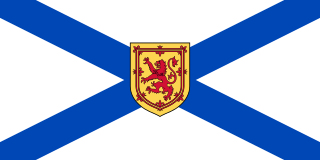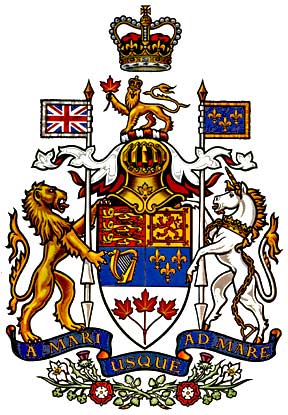
Saskatchewan is one of Canada's provinces, and has established several provincial symbols. [1]

Saskatchewan is one of Canada's provinces, and has established several provincial symbols. [1]
| Symbol | Image | Adopted | Remarks | |
|---|---|---|---|---|
| Coat of arms | Coat of arms of Saskatchewan |  | September 16, 1986 [2] | Granted by royal proclamation of Queen Elizabeth II. |
| Shield of arms | Shield of Saskatchewan |  | August 25, 1906 [3] | Shield of arms granted by the Royal Warrant of King Edward VII. |
| Provincial symbol | Saskatchewan's Wheat Sheaf | 1977 [4] | Used to identify government programs and organizations. | |
| Flag | Flag of Saskatchewan | 1969 [5] | Green for northern forests, gold for southern grain fields. | |
| The Great Seal | The Great Seal of Saskatchewan |  | May 7, 1991 [6] | First Great Seal of Saskatchewan granted by royal warrant of King Edward VII on August 25, 1906, The Great Seal of Saskatchewan of 1991 was authorized by an Order-in-Council. |
| Flower | Western red lily Lilium philadelphicum var. andinum |  | 1941 [7] | It is a protected species. |
| Bird | Sharp-tailed Grouse Pedioectes phasianellus jamesi |  | 1945 [8] | The Sharp-tailed Grouse lives year-round in Saskatchewan. [9] |
| Tree | Paper Birch Betula papyrifera |  | 1988 [10] | Used as firewood, for plywood, and for construction of canoes. [9] |
| Mineral | Potash |  | February 1996 [11] | Was given official status by amendments to The Provincial Emblems and Honours Act in May 1997. |
| Animal | White-tailed deer Odocoileus virginianus |  | 2001 [12] | First appeared on Saskatchewan's coat of arms in 1986. |
| Grass | Needle-and-thread grass Hesperostipa comata |  | 2001 [13] | It was selected by a coalition of environmental, wildlife and agricultural organizations. |
| Fruit | Saskatoon Berry Amelanchier alnifolia |  | 2005 [7] | |
| Fish | Walleye Sander vitreus |  | 2005 [14] | |
| Flag | Fransaskois Flag | 2005 [15] | The gold color represents the wheat fields of Saskatchewan, the cross is for the Catholic Church in Fransaskois, and the green color is for northern forests. The red fleur de lis symbolizes "la Francophonie". | |
| Sport | Curling |  | 2001 [16] | A well known sport in Saskatchewan since the 1880s. |
| Tartan | District Tartan |  | 1961 [17] | The provincial tartan was registered with the Court of Lord Lyon King of Arms in Scotland. |
| Tartan | Dress Tartan | 1997 [18] | Saskatchewan dress tartan was introduced for competitive highland dancers on the occasion of the Canadian Interprovincial Highland Dancing Championships. The original provincial tartan, with the off-white line becoming the background colour of the dress version. | |

Saskatchewan is a province in Western Canada, bordered on the west by Alberta, on the north by the Northwest Territories, on the east by Manitoba, to the northeast by Nunavut, and to the south by the United States. Saskatchewan and Alberta are the only landlocked provinces of Canada. In 2023, Saskatchewan's population was estimated at 1,225,493. Nearly 10% of Saskatchewan's total area of 651,900 km2 (251,700 sq mi) is fresh water, mostly rivers, reservoirs, and lakes.

The coat of arms of Saskatchewan, officially known as His Majesty's Arms in right of Saskatchewan, is the heraldic symbol representing the Canadian province of Saskatchewan.

The coat of arms of Manitoba is the heraldic symbol representing the Canadian province of Manitoba. The arms contains symbols reflecting Manitoba's British heritage along with local symbols. At the upper part of the shield is the red cross of St. George, representing England. On the left, the unicorn represents Scotland. The lower portion of the shield features a bison standing atop a rock on a green background, a symbol of First Nations peoples of the area who derived food and clothing from the animal.

The provincial flag of Saskatchewan was adopted in 1969. It is blazoned per fess vert and or, in the fly a prairie lily slipped and leaved proper, in the dexter chief an escutcheon of the coat of arms of Saskatchewan fimbriated argent. The symbolism within the flag is shown just with the colours; yellow representing the grain fields in the southern portion of the province where as the green represents the northern forested areas. The western red lily in the fly of the flag is the provincial flower. In 2017, The Minister of Parks, Culture and Sports designated September 22 as Saskatchewan Flag Day.

The flag of Nova Scotia consists of a blue saltire on a white field defaced with the royal arms of Scotland. Adopted in 1929 after a royal warrant was issued, it has been the flag of the province since January 19 of that year. It is a banner of arms modelled after the province's coat of arms. Utilized as a pennant since 1858, it was officially recognized under primary legislation as Nova Scotia's flag in 2013. When flown with the flags of other Canadian provinces and the national flag, it is fourth in the order of precedence.
U.S. states, districts, and territories have representative symbols that are recognized by their state legislatures, territorial legislatures, or tradition. Some, such as flags, seals, and birds have been created or chosen by all U.S. polities, while others, such as state crustaceans, state mushrooms, and state toys have been chosen by only a few.

Regional tartans of Canada are represented by all Canada's provinces and territories having a regional tartan, as do many other regional divisions in Canada. Tartans were first brought to Canada by Scottish settlers; the first province to adopt one officially was Nova Scotia in 1956, and the most recent province was Ontario, in 2000. Except for the tartan of Quebec, all of the provincial and territorial tartans are officially recognized and registered in the books of the Court of the Lord Lyon, King of Arms of Scotland.

The coat of arms of Victoria is the official heraldic symbol of the Australian state of Victoria. Victoria was the second state of Australia to gain arms, granted on 6 June 1910 by royal warrant of King George V. The state had been named in 1851 after his grandmother, who reigned at the time. The current version of the arms was granted 28 March 1978 in the royal warrant issued by Queen Elizabeth II.
Over the course of centuries, a multitude of national symbols and material items have arisen as uniquely Canadian or possessing uniquely Canadian characteristics. These symbols and items represent the culture of Canada—protectionism of that culture, identity, values, nationalism, and the heritage of its inhabitants.
Canadian royal symbols are the visual and auditory identifiers of the Canadian monarchy, including the viceroys, in the country's federal and provincial jurisdictions. These may specifically distinguish organizations that derive their authority from the Crown, establishments with royal associations, or merely be ways of expressing loyal or patriotic sentiment.

By the arrangements of the Canadian federation, the Canadian monarchy operates in Saskatchewan as the core of the province's Westminster-style parliamentary democracy. As such, the Crown within Saskatchewan's jurisdiction is referred to as the Crown in right of Saskatchewan, His Majesty in right of Saskatchewan, or His Majesty the King in right of Saskatchewan. The Constitution Act, 1867, however, leaves many royal duties in Saskatchewan specifically assigned to the sovereign's viceroy, the Lieutenant Governor of Saskatchewan, whose direct participation in governance is limited by the conventional stipulations of constitutional monarchy.
There are several symbols of Manitoba, one of the ten provinces of Canada. These symbols are designated by The Coat of Arms, Emblems and the Manitoba Tartan Act, which came into force on Feb 1, 1988.
Ontario is a province of Canada that has established several official emblems and symbols to reflect the province's history, natural resources, and its people. In addition to official symbols, several other emblems and symbols exist that are commonly associated with the province.
Highway 40 is a provincial highway in the north-west portion of the Canadian province of Saskatchewan connecting Alberta to Highway 3, four kilometres (2.5 mi) west of Shellbrook, Saskatchewan. Areas of this highway between the Alberta border and North Battleford are called the Poundmaker Trail. Pitikwahanapiwiyin, commonly known as Poundmaker, was a Plains Cree chief known as a peacemaker and defender of his people. This is a primary Saskatchewan highway maintained by the provincial government. The highway is about 280 kilometres (174 mi) long and is entirely paved.
The symbols of Queensland represent the Australian state of Queensland and the Queensland Government. The different symbols and emblems represent both the state and the government. The official state emblems of Queensland are prescribed in the Emblems of Queensland Act 2005.

Canadian heraldry is the cultural tradition and style of coats of arms and other heraldic achievements in both modern and historic Canada. It includes national, provincial, and civic arms, noble and personal arms, ecclesiastical heraldry, heraldic displays as corporate logos, and Canadian blazonry.

The following outline is provided as an overview of and topical guide to Saskatchewan:
The Caledonian Curling Club, also known as the Callie, is a curling club located in Regina, Saskatchewan, Canada. Established in 1915, the club is among the oldest in the province and has been the home of many championship teams, including the Sandra Schmirler rink, which won three provincial, national, and world championships in the 1990s and the gold medal at the 1998 Winter Olympics.

District tartans for the Commonwealth of Australia and for each of its constituent States have been registered in the Scottish Register of Tartans (SRT). Additionally, fashion tartans covering either Australia as a whole, or its capital city, Canberra, have been registered in the SRT, as have district tartans in respect of some of Australia's local government areas.